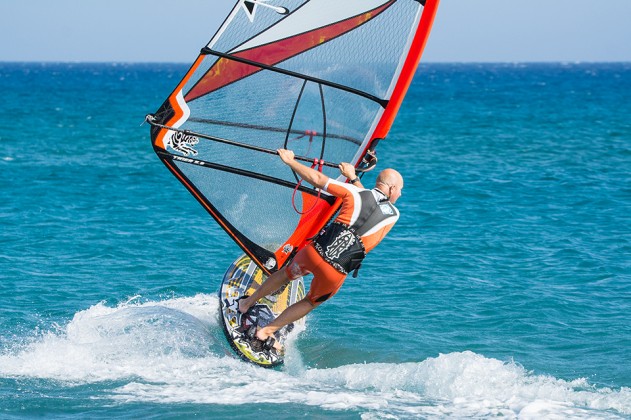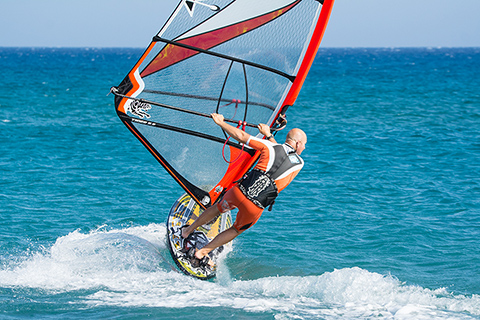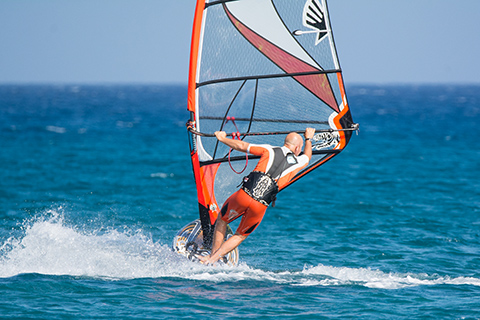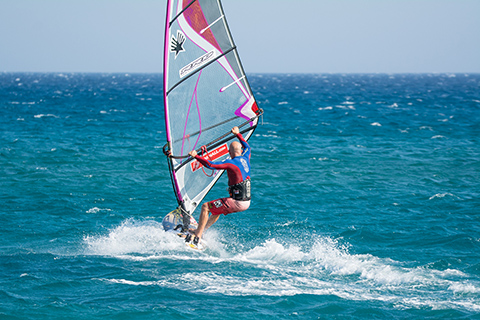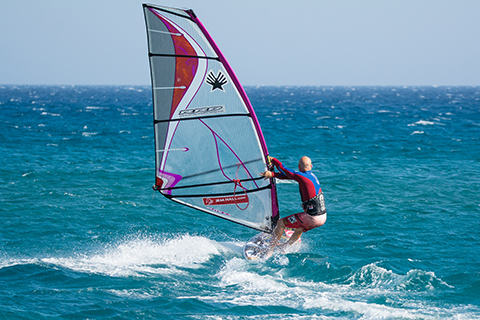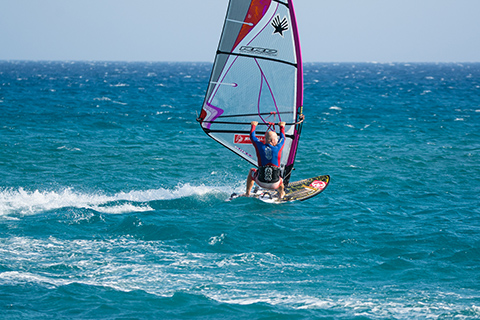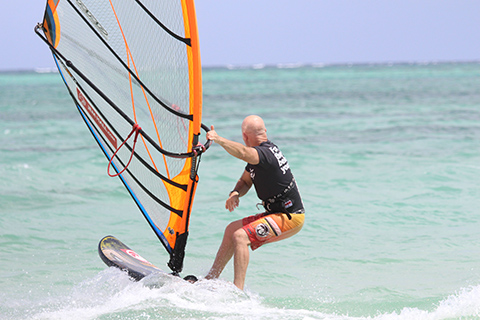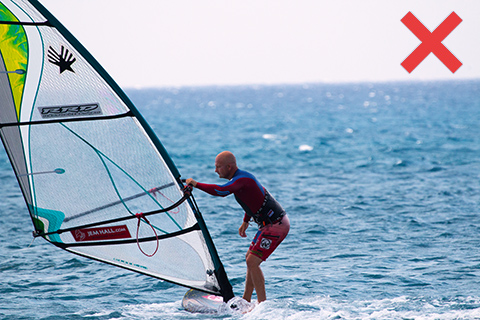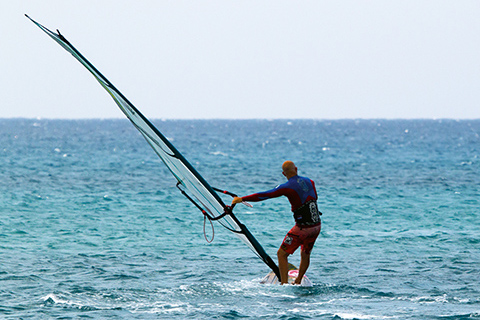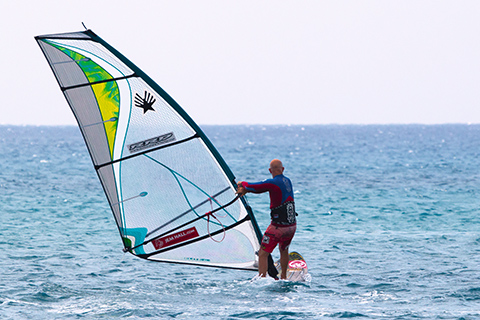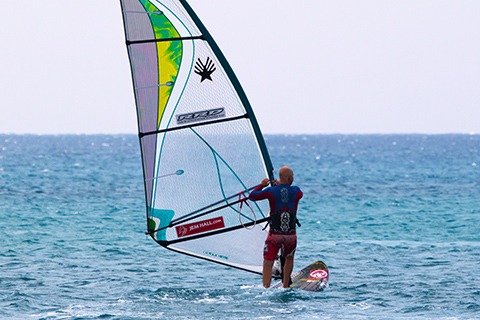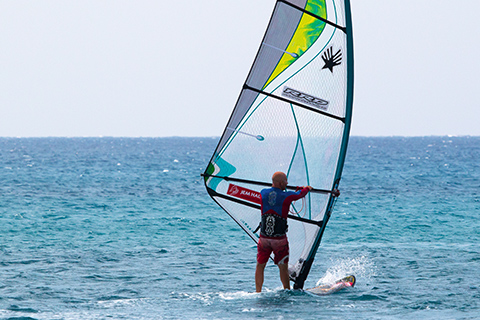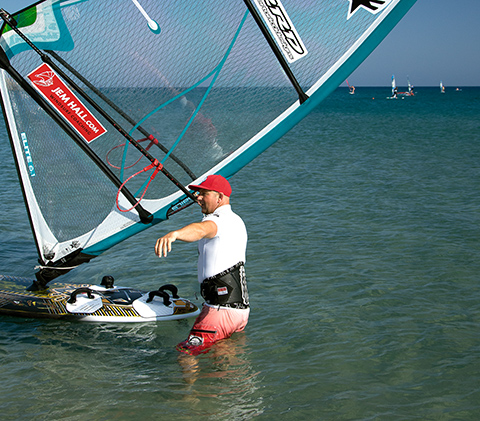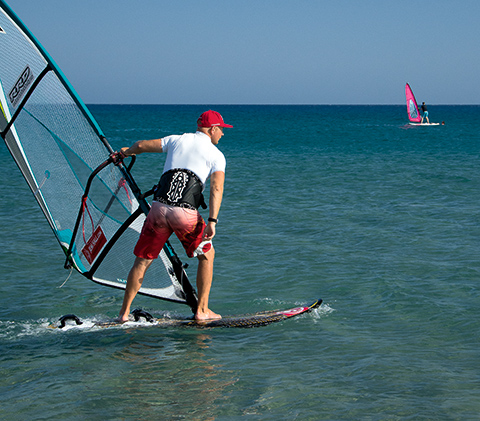JEM HALL
MOVE ON UP – WINDSURFING TECHNIQUE
END GAME
This month I am going to focus primarily on assisting you to fire out of your gybe exits and give you a strong End Game. Most moves start with a solid base and people believe that their less than clean endings are based on their exits, however as we all now know they are traced back to the preparation for a move, and yours is now rock solid as per the guidance in my “Preparation, preparation, preparation” article. We can all improve in this so please reread and recap on this article as you both brush up, and refine, on H.U.F. in your gybes, and your tacks – (move Hand/s, Unhook and then come out of the Foostrap/s).
Words Jem Hall // Photo Nicolas Jones & Brett Kenny
www.jemhall.com
(This feature originally appeared in the November/December 2015 issue of Windsurf Magazine. To read more features like this first, Print and Digital subscriptions are available. Prices include delivery globally for 10 x issues a year!)
// Look out of your duck gybe and gybe exits, get low and keep the rig away. PHOTO Nicolas Jones
KEEP IT SIMPLE
I like to keep my coaching simple and follow simple targets in all my sailing and so – might ask myself these self-coaching questions to prompt reflection and action – Am I low enough? Where are my hands on the boom? Am I looking where I need to be? What could I exaggerate?
So let’s give you some simple principles that will pay huge dividends in your End Game. Take these on board:
- Look out of your exit, i.e. where you want to head towards; simple but so effective. Look out of your gybe in the middle and continue this all the way through.
- Get low; the former tip actually really helps you with this. Focus on pivoting your feet in your transitions, and this requires you to bend your ankles which also means you have to bend your knees. Get down, James Brown in your moves!
- Keep the rig away; this starts in Prep. to the move but also in the mid part, it gives you space to transition your feet. Then upon firing out of your exit, look to get that rig away and this will force you to Get Low and maintain looking where you want to end up.
I keep repeating these tips and you may think but I do all that, just aim to exaggerate them and progress will follow. And if you come on a coaching holiday then we can see what really goes on in detailed video feedback sessions. Your actual dynamism in moves is rooted in your straight line stance, therefore look upwind when sailing, get low (bending your back leg) and outboard, and ensure you have distance from the rig.
“ Look, get Low and Keep the rig away ’’
// Look out of your exit, get low and rig away to up your end game. PHOTO Nicolas Jones
JEMS EXIT GEMS
In addition to the simple principles above, let’s give you some of the wisdom I have built up through thousands of hours of coaching.
- Never ever give up a move – no retreat, no surrender. Some people when they are slightly out of position just let it go and fall off, or jump in the water. Don’t! Fight it out and look to recover what you feel might be irretrievable. Rarely are moves totally clean and so you should look to develop you whole repertoire of recovery skills, and if you never give up, well this is exactly what you will do so there is actually a self-fulfilling prophecy here. This strategy will furthermore develop the necessary active recovery required in a huge majority of windsurfing moves.
- Move that rig. Take the rig through bigger circles of motion. This requires us to be dynamic with the concomitant benefit that you will actually make more moves and yes – Look, get Low and Keep the rig away.
Go out in light winds and go for bold dynamic rig movements to replicate the above and build up your recovery database. When I’m coaching I am looking to change people’s default recovery position of pull rig in, look at sail and stand up and move that towards – Look away from the sail, get and be Low and then they can Keep the rig away much easier to give them time and space. Again, this all starts in a straight line!
// Take the clew first power, look, stay out and low as you carve off heels and dynamically rotate rig’ PHOTO Nicolas Jones
SKILLS AND DRILLS
For people to really improve in all their moves it is important to break the move down and both focus on and practice the component parts. On my coaching holidays we really utilise any light winds to move on up on a floaty board or WindSup. Here are some of the Jedi drills, which are also covered in last summer’s technique features and online:
- Clew first beachstarts; get into position and come up onto the board clew first, and then rotate the rig. Aim to sail clew first and then to rotate the rig and take the rig through a big circle. Remember your key principles; look, low and away.
- Light wind gybes; steer in with nice wide hands and feet. Look, low and away in the middle and get those hips across. Sail out clew first and ensure your hips stay out and back. Then take the rig through a big circle to rotate the rig and aim to feel the rear heel steering the board as you rotate the rig, and also resist any temptation to look at your hands or the sail!
- Two second rule; perform a light wind gybe and then after sailing clew first, and your mast hand sliding down the boom, guide the rig to the back of the board as your hips move Forwards AND Outboards (slide and guide). Then just pause there and be comfortable in this counterbalance position, rig back and body forwards and out. This buys you time to gain control and for the board to turn to across the wind.
REFINE AND REFLECTION
“If you think you can, you can. If you think you can’t, you’re right.” Henry Ford. Believe (and invest) in you!
// If you look out the turn, keeping low and out then you can carve OUT of your gybes. PHOTO Brett Kenny
// Gear gazing, upright and close to the rig, not looking pretty’ PHOTO Nicolas Jones
CARVE IT OUT
I will now give you some more precise tips for coming out of your gybes smoother, faster and drier. I love to ask questions when coaching in order to help people develop their very own self coaching (a vital key to actually improving) and I might ask what body part do we carve with? Answers might be toes, calves or legs and so I say – yes we carve in on the former but we carve out on our heels. People look a bit dumbfounded by this but they start to get it and then examine my demos and movies much more closely. I can safely say that the main key to gybe exit improvement and to planing out of your gybes is to carve out on your heels!! And guess what, to do this you really have to Look, be Low and Keep the Rig Away. Ok, now I have your attention I want to recap on some of the main gybe Fire Exits:
- Bent back leg in, bent back leg out: Keep low, and think plié, with the old front heel switching across to meet the old back toes as you SWITCH your feet, and then the new front foot steps forward. Bent ankles and knees means you will pivot
- Take some power clew-first; so to do this you must be back, low (looking) and out. This is where you will first feel the carving heel pressure.
- Slide the front hand: Move your front (mast hand) back down the boom to the mast to ease the rig rotation.
- Send it: Rotate the rig and take it through a big circle to take the weight out of it, take it way back and then drive it forward. A flip is a small circle and does not give you enough time to heel carve out and finish your turn.
- ‘Get down James Brown’: After the rig rotation finishes, remember your strapping up tips and pull down hard on the boom and bend your back leg.
- Straps and then hook in: Aim to strap up and then hook in like a good active planer. This in itself WILL give you planing gybes and avoids catapults. Plus it allows you to choose your exit sailing line!
The above points are really worth working on and once these are really clicking in you can really start to take action and micro manage your End Game. Let’s look at some of my Jedi tips:
- Own clew first: I will say it again and again. Nail this skill and have a warrior attitude towards it, we are in a tough sport so build your toughness here.
- Mast hand is new power hand: when clew first you can control power by sheeting in with your mast hand and dropping lower, or sheet out on your mast hand and slightly raise your hips to produce power.
- Pull down on the clew to flatten board: Your front hand creates the maximum downforce so be low and pull down on it. This also lightens the load on your mast hand prior to sliding along the boom towards the mast to help you rotate the rig.
- Rig flip button: With your mast hand at the front of the boom, extend your thumb down the boom to assist the ‘slide and guide’ in the rig rotation.
- Carve off heels: Again the Jedi of all gybe exit tips. This begins with hips going to the inside mid gybe and can continue if you stay outboards and low.
- Send it: Send the rig back, as you whip the clew and keep the heels carving as you move forwards and out. Yes, Look, Keep low and have the rig away!
- Reach under and collect overhand: The old back hand should reach under your old mast hand as this is where the space is as you are so damn low. It should collect the rig in an overhand grip as this how we get planing most often and gives you maximum downforce, distance from the rig and means you can recover in a waterstart position if necessary.
- Work hard: Never give up and fight to finish the gybe and to build speed back up. A moving exit can become a planing exit with a bit of focus and determination.
What you put in is what you get out of your End Game. People put in some effort in the prep phase, quite a bit in the carve and in the middle and then often the least at the end. The most physical part of a good gybe should be the unhook and bear away, and even more so your warrior Fire Exit. Focus, believe and Enjoy this journey.
// Take the rig through a big circle to smooth up the rotation’ PHOTO Nicolas Jones
// Dry gybe drills will really boost your vision, handwork and wind awareness’ PHOTO Nicolas Jones
// Rig back, body forwards and pause and then finish the rig rotation’ PHOTO Nicolas Jones
RRD boards, wetsuits, softwear, Ezzy sails and Pro Sport Sunblock sponsor Jem Hall. Get him live and direct on one of his highly acclaimed coaching holidays. You can also follow him on twitter / Facebook and Instagram.
www.jemhall.com



